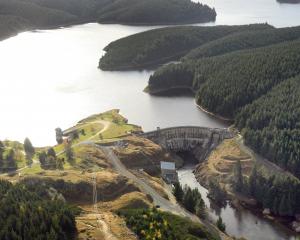
Forsyth Barr broker Damian Foster said yesterday lake levels were about 80% of average.
Both North Island and South Island storage levels were below average, although the recent storm would have provided a welcome boost to North Island storage.
Snow storage had been nearly exhausted and Meridian Energy estimated it only had 48GWh left compared with the 793GWh of storage it normally had at this time of year.
''In essence, from now on, the only snow melt going into lakes will be from permanent snow and ice that usually survives summer.''
It would be a surprise if melt from permanent stores made up the 745GWh shortfall, he said.
As weak La Nina conditions prevailed, the National Institute of Water and Atmospheric Research continued to forecast below average rainfall and river flows in the South Island.
North Island catchments were likely to have above average rainfall.
''Clearly, it is not possible to predict the weather out to winter 2018, but conditions are more conducive to high wholesale electricity prices than they were in 2017,'' Mr Foster said.
Electricity demand in the past couple of months had been firm compared with late 2016, mainly because of strong irrigation demand, he said.
More of the same was expected this year.
Irrigation and heating/cooling demands were likely to be the main reasons for variations to previous years. Underlying demand was expected to remain flat.
The forward futures curve was showing the market was increasingly concerned about lake levels, he said.
The short-dated price was $97 per MWh, $18 per MWh higher than the long-dated futures price.
If conditions stayed dry, the price was expected to surge further.
In comparison, at the same time in 2012, the short-dated futures price was $87 per MWh, just $2 per MWh higher than the long-dated price.
The short-dated futures price then surged, peaking at $140 per MWh in mid-February 2012, $41 per MWh higher than the long-dated price at the time.
The market was over-supplied with generation in 2012, whereas now it was not, which provided some indication of where wholesale prices could get to, Mr Foster said while acknowledging hedge arrangements were more sophisticated now than in 2012.
High wholesale electricity prices caused short-term winners and losers.
Typically, Genesis should be the main winner and Contact Energy and Meridian the losers. Mercury and Trustpower could be either, depending on North Island hydro volumes, he said.
In the medium-term, all the generator/retailers would be winners as high wholesale electricity prices were reflected in commercial and ultimately retail customer prices.
The 2018 retail market was expected to be more of the same, Mr Foster said.
The small start-up retailers would continue to grow faster than the big five.
Flick Electric and Electric Kiwi growth might slow a little because of the high wholesale electricity prices being negative for Flick and the need for Electric Kiwi to move to break even quickly.
Vocus NZ subsidiary Simply Energy would probably continue to push hard for customer numbers while Vocus was up for sale, he said.
Genesis, Contact and, to a lesser extent, Trustpower, ended 2017 with electricity customer loss momentum.
Mercury and Meridian consistently gained customers in 2017.
Genesis was expected to continue losing customers during 2018, at least in the early part. Its negative momentum dated to March 2016 and it would take a drastic change to turn that around, Mr Foster said.
''Our central forecast is the customer bases of the other large retailers will largely stay flat.''
Forsyth Barr expected new technology momentum in the electricity market but by the end of the year it would still be hard to notice the effects of the new technology on the wider grid.
While growth rates were likely to be impressive, the installed solar and electric vehicle charging bases would still be small, Mr Foster said.
Solar penetration rates had flatlined but a greater push towards commercial solar systems was likely where the commercial electricity demand better matched solar generation.
As part of the Government's family package, a winter package will be introduced this year to help pensioners and beneficiaries pay for their energy use.
The programme will run for 13 weeks from July 1. People living alone will get $20.46 a week, or about $266, for the period. Couples will receive $31.82 a week, or nearly $414 for the period. In future years, it will start on May 1 and continue for 22 weeks.
When fully implemented, the annual payment will be $450 for single people with no dependent children, and $700 for couples or single people with dependent children.













